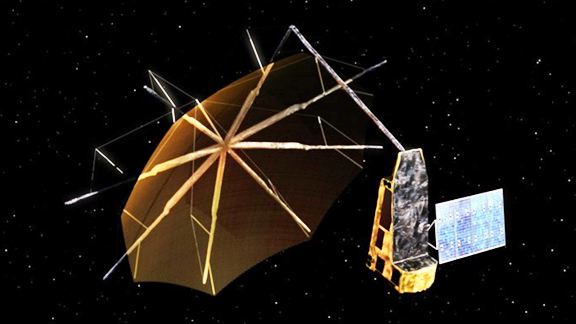

Arianespace and the European Space Agency have signed a launch services contract with a Vega launch vehicle for the Earth Explorer Biomass.
This is the seventh mission in ESA's Earth Explorer program and will provide global maps of the amount of carbon stored in the world's forests and how it changes over time, mainly through absorbing carbon dioxide from fossil fuel burning, deforestation and change in land use. Biomass also will provide essential support to United Nations treaties on the reduction of emissions from deforestation and forest degradation.

Artistic rendition of ESA's Earth Explorer Biomass satellite. Image by ESA.
The Biomass mission will use a Vega launch vehicle, with the launch period starting in October 2022 from the Guiana Space Center, Europe’s Spaceport in French Guiana (South America). Vega is part of the Arianespace launcher family, along with the Ariane 5 heavy launcher and the medium-lift Soyuz; all three are operated from the Guiana Space Center. The industrial prime contractor for Vega is Avio, based in Colleferro, Italy.
The satellite will have a mass at liftoff of approximately 1,200 kg. and will be placed in a dawn-dusk, SSO at an altitude of 666 km. Forest type and forest cover worldwide can be detected by today's satellites, but Biomass will take the information to the next level.
The satellite will carry the first P-band synthetic aperture radar (SAR), able to deliver accurate maps of tropical, temperate and boreal forest biomass in terms of tons/hectare with a resolution of 50 to 100 meters. The global mass of trees is not obtainable by ground measurement techniques. Other innovative applications that can be explored for the first time from space with the Biomass radar are the mapping of topography under dense vegetation and subsurface geology in deserts.
Biomass will spend at least five years making detailed observations and witnessing at least eight growth cycles in the world's forests. Observations from this new mission will also lead to better insight into the rates of habitat loss and, as a result, the effect this may have on biodiversity in the forest environment.
Airbus Defence and Space (UK) is developing and building the Biomass spacecraft using a bespoke structure embedding the AS250 avionics. The Explorer is based on the Astrobus Platform Line used, notably, on the following missions: SPOT6/7, KazEOSat-1, SEOSAT/Ingenio, PeruSAT-1 and Sentinel-5 Precursor.
Following the contract signature, Josef Aschbacher, Director of Earth Observation at ESA, and noted that mapping forest biomass from space is a technical challenge as forests are complex structures. Nevertheless, the Biomass mission is up to the task and will spend at least five years in orbit, to deliver critical data to understand more about the carbon cycle and how our forest resources are changing.
Stéphane Israël, CEO, Arianespace, added the company is proud to fly the Biomass satellite with Vega. Once again, Vega guarantees autonomous European access to space, enabling ESA to carry out a crucial mission as we face the challenge of climate change.

